| |
A brief description of fascinating and breathtaking places in Utrakhand

 NAINITAL NAINITAL
Nainital is a beautiful hill district nestled in the lap of central himalayas
in the Kumaon region. It's subtle yet pristine glory is manifested in
the lofty snow capped peaks, green valleys & serene lakes that have tempted
lovers of beauty since times immortal.: ( 1938 mts.) : It is renowned
as India's lake district, surrounded by Naina peak ( 2611 mts.), Laria
Kanta ( 2481 mts.), Snow View (2270 mts.), and Dorothy's Seat ( 2292 mts.)
all offering enchanting views. The major lakes are Bhimtal, Sattal, Naukuchiatal
and Khurpatal. Other important places in Nainital district are the Corbett
National Park, India's most popular wild life reserve.
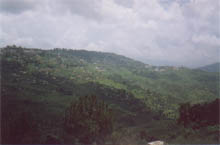
 ALMORA ALMORA
Almora is situatead at an elevation of 5400 ft in the Kumaon Hills, Almora
is known for it's healthy climate.It is perched atop the 5 km long saddle
shaped ridge of Kashya Hill which is mentioned in ancient scriptures.
The town of Almora was founded about 1560 AD by Balo Kalyan Chand, the
Raja of Champawat. It was ruled by the Chand Rajas upto the 18th century.
The Gorkhas ruled for about 25 years, after which it came under the British
control till independence.
Almora is the cultural centre of Kumaon & a picturesque mountain resort.While
it is bordered by the gentle hills of Kumaon on three sides, its northern
front affords a breathtaking view of the Trishul peaks. Sunrise offers
a particulary beautiful view of the greater Himalayas.
.) : The city of Almora lies amidst terraced slopes along a saddle ridge.
The majestic panorama of the Himalayas can be seen from Almora.Kausani,
53 Kms. from Almora, offers spectacular views of Trishul, Nanda Devi and
Nanda Kot Peaks. Bageshwar, 74 Kms. from Almora is the base camp for trekkers
to Pindari, Kafani, Sunderdhunga and Namik Glaciers. Binsar, 36Kms. from
Almora in a reserve forest area offers glorious views of the Himalayas.
The temples in Almora district, some of which date back to a thousand
years are known as 'Himdari' style of architecture - Jageshwar (37Kms.)
has 150 shrines dedicated to Lord Shiva; Baijnath (65 Kms.) has a 41/2
feet high image of Goddess Parvati; Katarmal ( 17Kms.) has an ancient
Sun Temple, while Gannath ( 47 Kms.) and Bageshwar ( 74Kms.) have Shiva
temples. Dronagiri ( 52 Kms. from Ranikhet) is an ancient Shakti Peeth
held in great reverence by the locals.
Area : 11.9 sq.km
Altitude : 5400 ft. above sea level
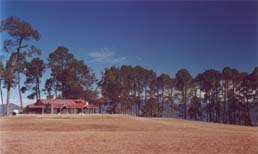
 RANIKHET RANIKHET
Ranikhet is situated at 1829 mtrs this sylvan retreat offers an interesting
mix of hill & military cultures. According to legends, a queen, in the
course of a journey came by this spot & was so enchanted by it that she
settled down here.Ranikhet has forest of oak & pine and is a fine place
to enjoy a panoramic view of the Himalayas, from the Bhagiriti peaks in
the west to the Nanda kot in the east.It is an ideal holiday for nature
lovers and its main attractions, apart from it's natural beauty are a
golf course, the orchids of Chaubatia and the Jhoola Devi temple.
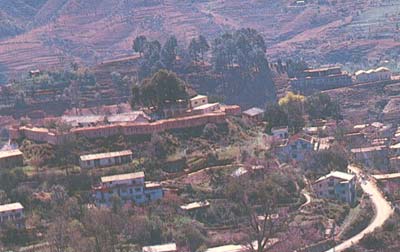
 PITHORAGARH PITHORAGARH
The district of Pithoragarh, bordering
Tibet and Nepal, is a treasure house of attractions for visitors, mountaineers,
tourists, iconologists and the religious minded.
The town, located in the midst of an extensive valley, has many remnants
of historic fortifications dating back to the time of Chand Rajas of Kumaon.
The Valley about 8 km in length and 5 km in breadth, resembles Kashmir
valley ona miniature scale. Pithoragarh, the headquarter-town of the district
of very name, is located in sprawling vballey which has charm of its own,
is one of the lovelist in the Uttar Praddesh hills.
Champawat
Champawat, the ancient capital of the Katyuri and Chand Rajas, is an idyllic
resort located in the lush Champa Valley of Kumaon. Situated at a height
of 1615mtrs., it is on the road to Pithoragarh. It was at Champawat the
Lord Vishnu is said to have appeared in his tortoise incarnation (Kurmavatar),
hence Kumaon came to be known as Kurmanchal. Kumaon is also the legendary
domain of Lord Shiva.
While the ruins of the fort and temples speak of the historical and religious
importance of Champawat's past, the scenic beauty of the place is still
abundant, the enjoyable.
The Kedarnath Shrine, one of the 12 Jyotirlingas of Lord Shiva, is a scenic
spot situated , against the backdrop of majestic Kedarnath range. At an
altitude of of 3,581 mt. it is a 14 km trek from gaurikund.
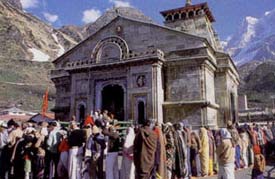
 KEDARNATH KEDARNATH
Kedar is another name of lord Shiva, the
protector & the destroyer. Shiva is considered the embodiment of all passions
- love, hatred, fear, death & mysticism which are expressed through his
various forms.
According to legend, the pandavas after having won over the kauravas in
the Kurukshetra war, felt guilty of having killed their own brothers &
sought the blessings of Lord Shiva for redemption.He eluded them repeatedly
& while fleeing took refuge at Kedarnath in the form of a bull. On being
followed he dived into the ground, leaving his hump on the surface. The
remaining portions of Lord Shiva appeared at four places and are worshiped
there as his manifestations.
The arms appeared at Tunganath, the face at Rudranath, the belly at Madmaheshwar
& his locks at Kalpeshwar. Kedarnath including these four shrines is treated
as Panch Kedar
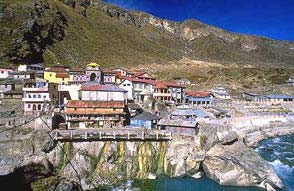
 BADRINATH BADRINATH
Badrinath is situated in the lap of Nar-Narayan
Parvat with the towering Neelkanth Peak (6,597 mts) in the background,
Badrinath is one of the most reverred Hindu Shrines of India.
Badrinath situated at an elevation of 3,133 mtrs is considered to be amongst
the most pious for hindus. With it's great scenic beauty & attractive
recreational spots in the vicinity, Badrinath attracts an ever increasing
number of Secular visitors year after year.
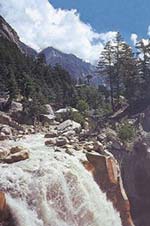
 GANGOTRI GANGOTRI
Gangotri is one of the Char Dhams of Uttarakhand.Situated
in the magnificient Garhwal Himalayas at an elevation of 3048 meters &
105 Kms from uttarkashi. The Gangotri shrine is seen as the spiritual
source of Hinduism's most sacred river, the Ganga. According to Hindu
mythology, Ganga, the stream of life, was granted as a reward for king
Bhagirathi's severe penance and the river is worshiped as a deity. The
physical source of the river is at Gaumukh, 18 km south-east of Gangotri,
along the gangotri glacier.
The temple at gangotri is visited by thousands of pilgrims between May
& November, was built by a Gorkha Commander Amar Singh Thapa in the early
18th century.
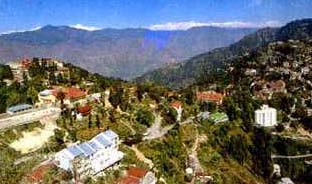
 MUSSOORIE MUSSOORIE
Mussoorie -In 1827, Captain Young of the
British Army chanced upon his extraordinarily beautiful wooded reige &
created the centre around which the hill station grew. Just 38 km from
Dehradun, Mussoorie offers views of both the snow capped Himalayan ranges
to the north & the Shivaliks and plains to the south. The erstwhile aristocratic
resort is now a Popular hill station & promises a variety of entertainment
throughout the year.
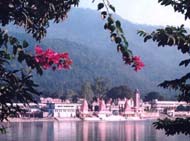
 RISHIKESH RISHIKESH
Rishikesh
is set along the banks of the Ganga at its confluence with Chandrabhaga,the
holy river just emerged from the high mountains. Thickly wooded hills
of the terrai straddle it's banks & the waters run deep & silent. Rishikesh
has long been a spiritual centre.
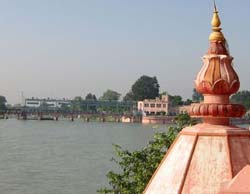
 HARIDWAR HARIDWAR
Haridwar is the place where the Ganga enters the plains after a turbulent
journey in the Himalayas. Here, the river broadens and slows down considerably.
Haridwar is a town of temples, dharamsalas, ashrams and saints and sages
from all parts of India. The Ganga is worshipped in ghats, with colorful
ceremonies being performed at the Har-ki-Pauri. Different roads from northern
India reach Haridwar en route to Rishikesh and destinations higher up
in the mountains.
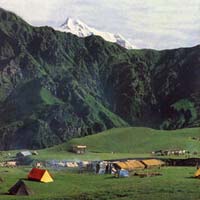
 DEHRADUN DEHRADUN
Nestled in a wide & thickly forested valley of the Shivalik ranges, known
for its salubrious climate. Once a stronghold of the Garhwal Kings & later
appropriated
by the british as a residential resort, the town has several institutions,
it's proximity
to Mussoorie is an added attraction.
Legend has it that Guru Dronacharya, a saint & a great teacher of Mahabharat
epic, underwent severe penances here & thus the valley has acquired the
name after him.
Another significant historical event is that Guru Ram Rai, the Sikh Guru
camped in this valley at the place where the present Guru Ram Rai Darbar
exists.

 JIM
CORBETT PARK JIM
CORBETT PARK
The forests of Garhwal & Kumaon region, ranging from Terai to mixed deciduous
& alpine ranges, harbour some of the exotic species of our wildlife. Snow
leopards, thars, bharals, brown & himalayan black bears, serows, tigers,
leopards, elephants and an immense variety of avaian species inhabit the
preservation zones, like the sancturies & national parks, or open forests
dotting the countryside. Streams & rivers in stretches, teem with fish
like mahaseer, hill trout & conch.
Jim Corbett Park is the oldest park in India, extends along the banks
of the Ramganga river, encompassing the dense Sal Forests of the Himalayan
foothills & the Savannah vegetation of tall grassy meadows. This is one
of the richest areas for the typical big mammals of northern India, renamed
after Jim Corbett the famous hunter, author and pioneer conservationist
who helped set up this wildlife sanctuary.
With elevations in the Park ranging from 400m to 1210m there is a rich
diversity in habitat. Animals of the Himalayas and those of peninsular
India can both be seen here and over 50 mammal and 25 reptile species
have been recorded at Corbett. Among the predators are the tiger, leopard,
diverse species of lesser cats and the dhole - the wild dog.
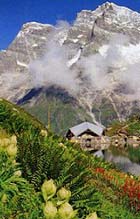
 HEMKUND SAHIB
HEMKUND SAHIB
This imposing star-shaped structure of stone and concrete masonry is on
the shores of the lake. An outlet behind the Gurudwara is the source of
the Lakshman Ganga. This sacred Sikh shrine is situated on the shores
of the Hemkund Lake (4320 mtrs).It marks the place where Guru Govind Singh,
the tenth and last Guru, unified with God after prolonged meditation in
his previous birth. The guru's autobiography whichcontains a detailed
description of the place helped two devout Sikhs, Sant Sohan Singh and
Havldar Mohan Singh to rediscover it. According to Hindu mythology, Himkund
of Lokpal as it is also known, is where Lukshman had done his penance.
|
 |
